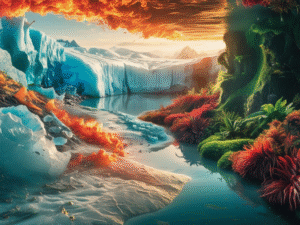Table of Contents
ToggleIntroduction
The environment forms the foundation of all life on Earth. From the air we breathe to the water we drink and the food we consume, everything is intrinsically linked to the natural world. However, human activities over the past few centuries—especially since the Industrial Revolution—have significantly altered the environment, leading to widespread degradation and the unprecedented challenge of climate change. Climate change is not just an environmental issue; it is a social, economic, political, and moral challenge that affects all aspects of human life.
In this article, we will explore the concept of environment and climate change, their causes, consequences, and potential solutions. The discussion will also highlight global efforts to combat climate change, the role of technology, and the importance of collective responsibility.
Understanding the Environment
The term environment refers to the physical, chemical, and biological surroundings in which organisms live. It includes all natural elements such as air, water, land, forests, oceans, and biodiversity, as well as human-made structures. A balanced environment ensures the survival of species and maintains ecological stability.
However, with the rapid growth of human civilization, the environment has been subjected to overexploitation. Deforestation, industrialization, urbanization, overfishing, and large-scale mining have disrupted natural ecosystems. As a result, the Earth’s environment has been losing its resilience, making it vulnerable to global challenges like climate change.
What is Climate Change?
Climate change refers to long-term alterations in global or regional climate patterns, primarily characterized by rising global temperatures, shifts in weather patterns, melting glaciers, sea-level rise, and an increase in extreme weather events. While natural processes like volcanic eruptions and solar radiation contribute to climate fluctuations, current climate change is overwhelmingly driven by human activities, especially the emission of greenhouse gases (GHGs) like carbon dioxide (CO₂), methane (CH₄), and nitrous oxide (N₂O).
The burning of fossil fuels, industrial processes, large-scale agriculture, and deforestation are the primary contributors to GHG emissions. These gases trap heat in the Earth’s atmosphere, a phenomenon known as the greenhouse effect, leading to global warming and climate instability.
Causes of Climate Change
Burning of Fossil Fuels
Coal, oil, and natural gas are major energy sources for industries, transportation, and households. Their combustion releases vast amounts of CO₂, contributing significantly to the greenhouse effect.
Deforestation
Forests act as carbon sinks by absorbing CO₂ from the atmosphere. Large-scale deforestation for agriculture, urbanization, and logging reduces this capacity, worsening climate change.
Industrialization
Industrial processes release GHGs and pollutants into the atmosphere. The demand for mass production and energy consumption increases emissions substantially.
Agricultural Practices
Livestock farming releases methane, while the use of synthetic fertilizers emits nitrous oxide. Unsustainable farming practices degrade soil health and reduce the Earth’s natural carbon absorption ability.
Urbanization and Transportation
Expanding cities and the increasing number of vehicles powered by fossil fuels result in air pollution and rising emissions.
Waste Mismanagement
Improper disposal of waste in landfills leads to methane emissions. Plastic pollution further damages ecosystems and affects marine life.
Effects of Climate Change
The consequences of climate change are far-reaching and interconnected, affecting both natural systems and human societies.
Rising Global Temperatures
The average global temperature has already increased by over 1.1°C since pre-industrial times. This warming intensifies heatwaves, droughts, and other weather extremes.
Melting Glaciers and Polar Ice Caps
The Arctic and Antarctic regions are losing ice at alarming rates. This contributes to rising sea levels and threatens polar ecosystems.
Sea-Level Rise
Rising sea levels endanger coastal communities, submerge low-lying islands, and contaminate freshwater supplies with saltwater intrusion.
Extreme Weather Events
Hurricanes, cyclones, wildfires, floods, and droughts are becoming more frequent and severe. These disasters displace communities and strain economies.
Loss of Biodiversity
Many species face extinction due to habitat loss, changing ecosystems, and altered food chains. Coral reefs, often termed the “rainforests of the sea,” are especially vulnerable.
Impacts on Human Health
Climate change contributes to respiratory diseases, heat stress, malnutrition, and the spread of vector-borne diseases like malaria and dengue.
Economic Consequences
Damage to agriculture, fisheries, infrastructure, and industries causes financial losses. Developing countries are particularly vulnerable due to limited adaptive capacities.
Climate Change and Sustainable Development
Climate change poses a direct threat to achieving the United Nations Sustainable Development Goals (SDGs). Goals such as poverty reduction, zero hunger, clean water, health, and sustainable cities are all impacted by climate change. For instance, agricultural disruptions due to erratic rainfall affect food security, while rising sea levels threaten coastal populations and infrastructure.
A sustainable approach to development requires integrating environmental protection into all economic and social policies. Balancing human needs with ecological preservation is the only way forward.
Global Efforts to Combat Climate Change
The Paris Agreement (2015)
Signed by nearly every country in the world, this agreement aims to limit global warming to below 2°C above pre-industrial levels, with efforts to restrict it to 1.5°C.
Kyoto Protocol (1997)
It was the first international treaty to set legally binding emission reduction targets for developed countries.
COP (Conference of Parties) Summits
Annual COP meetings under the UN Framework Convention on Climate Change (UNFCCC) provide a platform for nations to negotiate climate policies.
Renewable Energy Initiatives
Countries are investing in solar, wind, hydro, and geothermal energy as alternatives to fossil fuels.
Reforestation and Conservation Programs
Efforts are being made globally to restore forests, protect biodiversity, and conserve ecosystems.
Carbon Pricing and Trading
Mechanisms like carbon taxes and emissions trading systems encourage industries to reduce emissions by attaching a cost to carbon pollution.
Role of Technology in Addressing Climate Change
Renewable Energy Technologies
Solar panels, wind turbines, and hydropower plants reduce dependence on fossil fuels.
Carbon Capture and Storage (CCS)
Technologies are being developed to capture CO₂ from industrial processes and store it underground.
Electric Vehicles (EVs)
Transitioning to EVs reduces emissions from transportation.
Smart Cities and IoT
Efficient energy use, waste management, and green infrastructure in urban areas can lower emissions.
Artificial Intelligence and Big Data
These tools help predict climate patterns, optimize resource use, and monitor environmental changes in real time.
What Individuals Can Do
Adopt Sustainable Lifestyles
Reduce energy consumption, minimize waste, and prefer public transport or cycling.
Support Renewable Energy
Use solar power at homes where possible and encourage community adoption of green energy.
Plant Trees and Protect Green Spaces
Reforestation and afforestation help absorb carbon dioxide and restore biodiversity.
Reduce, Reuse, Recycle
Conscious consumption habits reduce environmental stress.
Spread Awareness
Educating others about climate change is vital in creating collective responsibility.
Challenges in Tackling Climate Change
Despite global awareness, several barriers remain:
Economic Interests: Fossil fuel industries and large corporations resist changes that may affect profits.
Political Will: International cooperation is often hindered by political conflicts and differing national priorities.
Inequality: Developing nations argue that developed countries, historically responsible for most emissions, should bear the larger share of responsibility.
Technological Gaps: Many countries lack access to advanced green technologies.
Public Apathy: Despite awareness, many people fail to take personal action, underestimating the urgency of the crisis.
Climate Change Ahead
Climate change is a global crisis that demands urgent, unified action. Nations must commit to emission reductions, accelerate investments in renewable energy, and ensure equitable transitions for all communities. Policies should prioritize environmental justice, recognizing that vulnerable populations suffer the most from climate-related impacts.
Education and awareness are equally crucial. By fostering environmental consciousness, societies can encourage collective action. Technology and innovation should be harnessed to create resilient economies that prioritize ecological sustainability.
Conclusion
The environment and climate change are deeply interconnected issues that shape the present and future of humanity. Climate change is no longer a distant possibility but an urgent reality affecting ecosystems, economies, and societies worldwide. While the challenges are immense, they are not insurmountable. Through collective global efforts, sustainable practices, and individual responsibility, it is possible to mitigate climate change and restore balance to the environment.
Humanity stands at a crossroads: one path leads to environmental degradation and irreversible consequences, while the other offers hope for a greener, sustainable, and resilient future. The choice lies in our hands.



